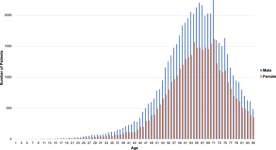
The prevalence of Dupuytren’s disease in patients with diabetes mellitus
Plater, F. Observations Vol. 3, 140 (Konig & Brandmyller, 1614).
Doane, A. S. Clinical Lectures on Surgery (Association of Physicians, 1833).
Jung, J., Kim, G. W., Lee, B., Joo, J. W. J. & Jang, W. Integrative genomic and transcriptomic analysis of genetic markers in Dupuytren’s disease. BMC Med. Genomics 12, 98 (2019).
Descatha, A. et al. Association among work exposure, alcohol intake, smoking and Dupuytren’s disease in a large cohort study (GAZEL). BMJ Open 4, e004214 (2014).
Descatha, A. et al. Diabète et rétraction de l’aponévrose palmaire. J. Hebdo Med. 20, 770 (1883).
Viger, J. De la rétraction de l’aponévrose palmaire chez les diabétiques. (Hachette Livre, 1883).
Broekstra, D. C., Groen, H., Molenkamp, S., Werker, P. M. N. & van den Heuvel, E. R. A systematic review and meta-analysis on the strength and consistency of the associations between Dupuytren disease and diabetes mellitus, liver disease, and epilepsy. Plast. Reconstr. Surg. 141, 367e–379e (2018).
Wang, M. L. et al. Circulating inflammatory cytokines alter transcriptional activity within fibrotic tissue of Dupuytren’s disease patients. J. Orthop. Res. 40, 738–749 (2022).
Rydberg, M. et al. Metabolic factors and the risk of Dupuytren’s disease: data from 30,000 individuals followed for over 20 years. Sci. Rep. 11, 14669 (2021).
Arkkila, P. E., Kantola, I. M. & Viikari, J. S. Dupuytren’s disease: association with chronic diabetic complications. J. Rheumatol. 24, 153–159 (1997).
Arkkila, P. E., Kantola, I. M., Viikari, J. S., Rönnemaa, T. & Vähätalo, M. A. Dupuytren’s disease in type 1 diabetic patients: a five-year prospective study. Clin. Exp. Rheumatol. 14, 59–65 (1996).
Ardic, F., Soyupek, F., Kahraman, Y. & Yorgancioglu, R. The musculoskeletal complications seen in type II diabetics: predominance of hand involvement. Clin. Rheumatol. 22, 229–233 (2003).
Aydeniz, A., Gursoy, S. & Guney, E. Which musculoskeletal complications are most frequently seen in type 2 diabetes mellitus? J. Int. Med. Res. 36, 505–511 (2008).
Bergaoui, N., Dibej, K. & el May, M. Association of cheiroarthropathy and Dupuytren’s disease in diabetes mellitus. Rev. Rhum. Mal. Osteoartic 58, 179–181 (1991).
Cagliero, E., Apruzzese, W., Perlmutter, G. S. & Nathan, D. M. Musculoskeletal disorders of the hand and shoulder in patients with diabetes mellitus. Am. J. Med. 112, 487–490 (2002).
Cederlund, R. I. et al. Hand disorders, hand function, and activities of daily living in elderly men with type 2 diabetes. J. Diabetes Complications 23, 32–39 (2009).
Chammas, M. et al. Dupuytren’s disease, carpal tunnel syndrome, trigger finger, and diabetes mellitus. J. Hand Surg. Am. 20, 109–114 (1995).
Chen, L. H. et al. Risk of hand syndromes in patients with diabetes mellitus: a population-based cohort study in Taiwan. Medicine 94, e1575 (2015).
Eadington, D. W., Patrick, A. W. & Frier, B. M. Association between connective tissue changes and smoking habit in type 2 diabetes and in non-diabetic humans. Diabetes Res. Clin. Pract. 11, 121–125 (1991).
Geoghegan, J. M., Forbes, J., Clark, D. I., Smith, C. & Hubbard, R. Dupuytren’s disease risk factors. J. Hand Surg. Br. 29, 423–426 (2004).
Günther, O. & Miosga, R. Dupuytren’s contracture as a late complication of diabetes. Z. Gesamte Inn. Med. 27, 777–782 (1972).
Kovacs, D., Demian, L. & Babes, A. Prevalence and risk of Dupuytrèn disease in patients with diabetes versus non-diabetic patients. Rom. J. Diabetes Nutr. Metab. Dis. 19, 373–380 (2012).
Macaulay, D., Ivanova, J., Birnbaum, H., Sorg, R. & Skodny, P. Direct and indirect costs associated with Dupuytren’s contracture. J. Med. Econ. 15, 664–671 (2012).
Noble, J., Heathcote, J. G. & Cohen, H. Diabetes mellitus in the aetiology of Dupuytren’s disease. J. Bone Joint Surg. Br. 66, 322–325 (1984).
Ouédraogo, D. et al. Manifestations rhumatologiques associées au diabète sucré chez le sujet noir africain: rheumatologic manifestations in Black African patients affected by diabetes mellitus. Médecine des Maladies Métaboliques 3, 520–523 (2009).
Pal, B., Griffiths, I. D., Anderson, J. & Dick, W. C. Association of limited joint mobility with Dupuytren’s contracture in diabetes mellitus. J. Rheumatol. 14, 582–585 (1987).
Ravid, M., Dinai, Y. & Sohar, E. Dupuytren’s disease in diabetes mellitus. Acta Diabetol. Lat. 14, 170–174 (1977).
Renard, E. et al. Increased prevalence of soft tissue hand lesions in type 1 and type 2 diabetes mellitus: various entities and associated significance. Diabete Metab. 20, 513–521 (1994).
Savaş, S. et al. The effects of the diabetes related soft tissue hand lesions and the reduced hand strength on functional disability of hand in type 2 diabetic patients. Diabetes Res. Clin. Pract. 77, 77–83 (2007).
Seidler, A. et al. Occupational, consumption-related and disease-related risk factors for Dupuytren’s contracture: results of a case-control study. Arbeitsmedizin Sozialmedizin Umweltmedizin 26, 218–229 (2001).
Spring, M., Fleck, H. & Cohen, B. D. Dupuytren’s contracture. Warning of diabetes? N. Y. State J. Med. 70, 1037–1041 (1970).
Zerajic, D. & Finsen, V. Dupuytren’s disease in Bosnia and Herzegovina. An epidemiological study. BMC Musculoskelet. Disord. 5, 10 (2004).
Mikkelsen, O. A. The prevalence of Dupuytren’s disease in Norway. A study in a representative population sample of the municipality of Haugesund. Acta Chir. Scand. 138, 695–700 (1972).
Saboeiro, A. P., Porkorny, J. J., Shehadi, S. I., Virgo, K. S. & Johnson, F. E. Racial distribution of Dupuytren’s disease in Department of Veterans Affairs patients. Plast. Reconstr. Surg. 106, 71–75 (2000).
Dibenedetti, D. B., Nguyen, D., Zografos, L., Ziemiecki, R. & Zhou, X. Prevalence, incidence, and treatments of Dupuytren’s disease in the United States: results from a population-based study. Hand 6, 149–158 (2011).
Hindocha, S., McGrouther, D. A. & Bayat, A. Epidemiological evaluation of Dupuytren’s disease incidence and prevalence rates in relation to etiology. Hand 4, 256–269 (2009).
Anthony, S. G., Lozano-Calderon, S. A., Simmons, B. P. & Jupiter, J. B. Gender ratio of Dupuytren’s disease in the modern U.S. population. Hand 3, 87–90 (2008).
Lee, H. H. & Satish, L. Biological targets for Dupuytren disease. Ann. Plast. Surg. 87, 355–358 (2021).
Lee, L. C. et al. Expression of a novel gene, MafB, in Dupuytren’s disease. J. Hand Surg. Am. 31, 211–218 (2006).
Grazina, R. et al. Dupuytren’s disease: where do we stand? EFORT Open Rev. 4, 63–69 (2019).
Takase, F. et al. Association of advanced glycation end products in Dupuytren disease. J. Orthop. Surg. Res. 13, 143 (2018).
Hinz, B., McCulloch, C. A. & Coelho, N. M. Mechanical regulation of myofibroblast phenoconversion and collagen contraction. Exp. Cell Res. 379, 119–128 (2019).
Gerrits, E. G., Landman, G. W., Nijenhuis-Rosien, L. & Bilo, H. J. Limited joint mobility syndrome in diabetes mellitus: a minireview. World J. Diabetes 6, 1108–1112 (2015).
Somai, P. & Vogelgesang, S. Limited joint mobility in diabetes mellitus: the clinical implications: the onset is insidious and may predate the recognition of overt disease. J. Musculoskelet. Med. 28, 118–124 (2011).
Thurston, A. J. Dupuytren’s disease. J. Bone Joint Surg. Br. 85, 469–477 (2003).
Riesmeijer, S. A., Werker, P. M. N. & Nolte, I. M. Ethnic differences in prevalence of Dupuytren disease can partly be explained by known genetic risk variants. Eur. J. Hum. Genet. 27, 1876–1884 (2019).
Al-Qattan, M. M. Factors in the pathogenesis of Dupuytren’s contracture. J. Hand Surg. Am. 31, 1527–1534 (2006).
Karna, E., Szoka, L., Huynh, T. Y. L. & Palka, J. A. Proline-dependent regulation of collagen metabolism. Cell Mol. Life Sci. 77, 1911–1918 (2020).
Akbar, M. et al. Attenuation of Dupuytren’s fibrosis via targeting of the STAT1 modulated IL-13Rα1 response. Sci. Adv. 6, eaaz8272 (2020).
Gelbard, M. K. & Rosenbloom, J. Fibroproliferative disorders and diabetes: understanding the pathophysiologic relationship between Peyronie’s disease, Dupuytren disease and diabetes. Endocrinol. Diabetes Metab. 4, e00195 (2021).
Khan, M. A. B. et al. Epidemiology of Type 2 diabetes—Global Burden of Disease and forecasted trends. J. Epidemiol. Glob. Health 10, 107–111 (2020).
Mobasseri, M. et al. Prevalence and incidence of type 1 diabetes in the world: a systematic review and meta-analysis. Health Promot. Perspect. 10, 98–115 (2020).
Goh, S. Y. & Cooper, M. E. Clinical review: the role of advanced glycation end products in progression and complications of diabetes. J. Clin. Endocrinol. Metab. 93, 1143–1152 (2008).
Nowakowska, M. et al. The comorbidity burden of type 2 diabetes mellitus: patterns, clusters and predictions from a large English primary care cohort. BMC Med. 17, 145 (2019).
Turk, Z., Mesić, R. & Benko, B. Comparison of advanced glycation endproducts on haemoglobin (Hb-AGE) and haemoglobin A1c for the assessment of diabetic control. Clin. Chim. Acta 277, 159–170 (1998).



